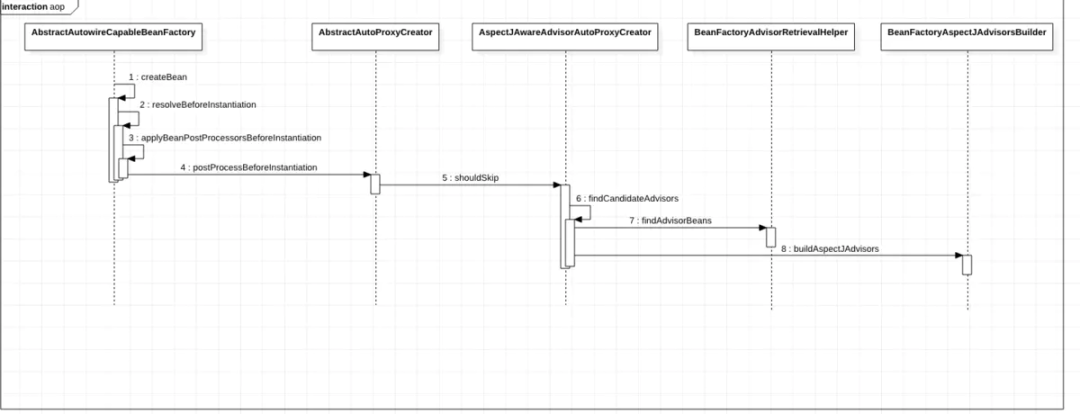一文读懂Spring中的AOP机制

点击上方老周聊架构关注我
一、前言
@Target({ElementType.METHOD})@Retention(RetentionPolicy.RUNTIME)@Documentedpublic @interface PrintLog {}
public class PrintLogAspect {(value = "@annotation(com.riemann.core.annotation.PrintLog)")public Object handlerPrintLog(ProceedingJoinPoint joinPoint) throws Throwable {String clazzName = joinPoint.getSignature().getDeclaringTypeName();String methodName = joinPoint.getSignature().getName();Object[] args = joinPoint.getArgs();Map<String, Object> nameAndArgs = getFieldsName(this.getClass(), clazzName, methodName, args);log.info("Enter class[{}] method[{}] params[{}]", clazzName, methodName, nameAndArgs);Object object = null;try {object = joinPoint.proceed();} catch (Throwable throwable) {log.error("Process class[{}] method[{}] error", clazzName, methodName, throwable);}log.info("End class[{}] method[{}]", clazzName, methodName);return object;}private Map<String, Object> getFieldsName(Class clazz, String clazzName, String methodName, Object[] args) throws NotFoundException {Map<String, Object > map = new HashMap<>();ClassPool pool = ClassPool.getDefault();ClassClassPath classPath = new ClassClassPath(clazz);pool.insertClassPath(classPath);CtClass cc = pool.get(clazzName);CtMethod cm = cc.getDeclaredMethod(methodName);MethodInfo methodInfo = cm.getMethodInfo();CodeAttribute codeAttribute = methodInfo.getCodeAttribute();LocalVariableAttribute attr = (LocalVariableAttribute) codeAttribute.getAttribute(LocalVariableAttribute.tag);if (attr == null) {// exception}int pos = Modifier.isStatic(cm.getModifiers()) ? 0 : 1;for (int i = 0; i < cm.getParameterTypes().length; i++) {map.put( attr.variableName(i + pos), args[i]);}return map;}}
public class Controller {public String findUserNameById( int id) {// 模拟根据id查询用户名String userName = "公众号【老周聊架构】";return userName;}}
二、Spring中的AOP机制
public List<Advisor> findAdvisorBeans() {String[] advisorNames = this.cachedAdvisorBeanNames;if (advisorNames == null) {advisorNames = BeanFactoryUtils.beanNamesForTypeIncludingAncestors(this.beanFactory, Advisor.class, true, false);this.cachedAdvisorBeanNames = advisorNames;}if (advisorNames.length == 0) {return new ArrayList();} else {List<Advisor> advisors = new ArrayList();String[] var3 = advisorNames;int var4 = advisorNames.length;for(int var5 = 0; var5 < var4; ++var5) {String name = var3[var5];if (this.isEligibleBean(name)) {if (this.beanFactory.isCurrentlyInCreation(name)) {if (logger.isTraceEnabled()) {logger.trace("Skipping currently created advisor '" + name + "'");}} else {try {// 核心方法advisors.add(this.beanFactory.getBean(name, Advisor.class));} catch (BeanCreationException var11) {Throwable rootCause = var11.getMostSpecificCause();if (rootCause instanceof BeanCurrentlyInCreationException) {BeanCreationException bce = (BeanCreationException)rootCause;String bceBeanName = bce.getBeanName();if (bceBeanName != null && this.beanFactory.isCurrentlyInCreation(bceBeanName)) {if (logger.isTraceEnabled()) {logger.trace("Skipping advisor '" + name + "' with dependency on currently created bean: " + var11.getMessage());}continue;}}throw var11;}}}}return advisors;}}
advisors.add(this.beanFactory.getBean(name, Advisor.class));public List<Advisor> buildAspectJAdvisors() {List<String> aspectNames = this.aspectBeanNames;if (aspectNames == null) {synchronized(this) {aspectNames = this.aspectBeanNames;if (aspectNames == null) {List<Advisor> advisors = new ArrayList();List<String> aspectNames = new ArrayList();// 找到所有的类(因为是Object所以基本上就是所有被spring管理的类)String[] beanNames = BeanFactoryUtils.beanNamesForTypeIncludingAncestors(this.beanFactory, Object.class, true, false);String[] var18 = beanNames;int var19 = beanNames.length;for(int var7 = 0; var7 < var19; ++var7) {String beanName = var18[var7];// 是否是Aspect(比如含有@Aspect注解)if (this.isEligibleBean(beanName)) {Class<?> beanType = this.beanFactory.getType(beanName);if (beanType != null && this.advisorFactory.isAspect(beanType)) {aspectNames.add(beanName);AspectMetadata amd = new AspectMetadata(beanType, beanName);if (amd.getAjType().getPerClause().getKind() == PerClauseKind.SINGLETON) {MetadataAwareAspectInstanceFactory factory = new BeanFactoryAspectInstanceFactory(this.beanFactory, beanName);// 生成AdvisorList<Advisor> classAdvisors = this.advisorFactory.getAdvisors(factory);if (this.beanFactory.isSingleton(beanName)) {this.advisorsCache.put(beanName, classAdvisors);} else {this.aspectFactoryCache.put(beanName, factory);}advisors.addAll(classAdvisors);} else {if (this.beanFactory.isSingleton(beanName)) {throw new IllegalArgumentException("Bean with name '" + beanName + "' is a singleton, but aspect instantiation model is not singleton");}MetadataAwareAspectInstanceFactory factory = new PrototypeAspectInstanceFactory(this.beanFactory, beanName);this.aspectFactoryCache.put(beanName, factory);advisors.addAll(this.advisorFactory.getAdvisors(factory));}}}}this.aspectBeanNames = aspectNames;return advisors;}}}if (aspectNames.isEmpty()) {return Collections.emptyList();} else {List<Advisor> advisors = new ArrayList();Iterator var3 = aspectNames.iterator();while(var3.hasNext()) {String aspectName = (String)var3.next();List<Advisor> cachedAdvisors = (List)this.advisorsCache.get(aspectName);if (cachedAdvisors != null) {advisors.addAll(cachedAdvisors);} else {MetadataAwareAspectInstanceFactory factory = (MetadataAwareAspectInstanceFactory)this.aspectFactoryCache.get(aspectName);advisors.addAll(this.advisorFactory.getAdvisors(factory));}}return advisors;}}
找到所有被 spring 管理的类(父类是 Object 的类)
如果类含有 @Aspect 注解,调用 advisorFactory.getAdvisors 方法生成对应的 advisor
返回advisors
org.springframework.aop.aspectj.annotation.ReflectiveAspectJAdvisorFactory#getAdvisorspublic List<Advisor> getAdvisors(MetadataAwareAspectInstanceFactory aspectInstanceFactory) {Class<?> aspectClass = aspectInstanceFactory.getAspectMetadata().getAspectClass();String aspectName = aspectInstanceFactory.getAspectMetadata().getAspectName();this.validate(aspectClass);MetadataAwareAspectInstanceFactory lazySingletonAspectInstanceFactory = new LazySingletonAspectInstanceFactoryDecorator(aspectInstanceFactory);List<Advisor> advisors = new ArrayList();Iterator var6 = this.getAdvisorMethods(aspectClass).iterator();// 遍历所有没有 @Pointcut 注解的方法while(var6.hasNext()) {Method method = (Method)var6.next();Advisor advisor = this.getAdvisor(method, lazySingletonAspectInstanceFactory, advisors.size(), aspectName);if (advisor != null) {advisors.add(advisor);}}if (!advisors.isEmpty() && lazySingletonAspectInstanceFactory.getAspectMetadata().isLazilyInstantiated()) {Advisor instantiationAdvisor = new ReflectiveAspectJAdvisorFactory.SyntheticInstantiationAdvisor(lazySingletonAspectInstanceFactory);advisors.add(0, instantiationAdvisor);}Field[] var12 = aspectClass.getDeclaredFields();int var13 = var12.length;for(int var14 = 0; var14 < var13; ++var14) {Field field = var12[var14];Advisor advisor = this.getDeclareParentsAdvisor(field);if (advisor != null) {advisors.add(advisor);}}return advisors;}
public Advisor getAdvisor(Method candidateAdviceMethod, MetadataAwareAspectInstanceFactory aspectInstanceFactory, int declarationOrderInAspect, String aspectName) {this.validate(aspectInstanceFactory.getAspectMetadata().getAspectClass());AspectJExpressionPointcut expressionPointcut = this.getPointcut(candidateAdviceMethod, aspectInstanceFactory.getAspectMetadata().getAspectClass());return expressionPointcut == null ? null : new InstantiationModelAwarePointcutAdvisorImpl(expressionPointcut, candidateAdviceMethod, this, aspectInstanceFactory, declarationOrderInAspect, aspectName);}
private Advice instantiateAdvice(AspectJExpressionPointcut pointcut) {Advice advice = this.aspectJAdvisorFactory.getAdvice(this.aspectJAdviceMethod, pointcut, this.aspectInstanceFactory, this.declarationOrder, this.aspectName);return advice != null ? advice : EMPTY_ADVICE;}
public Advice getAdvice(Method candidateAdviceMethod, AspectJExpressionPointcut expressionPointcut, MetadataAwareAspectInstanceFactory aspectInstanceFactory, int declarationOrder, String aspectName) {Class<?> candidateAspectClass = aspectInstanceFactory.getAspectMetadata().getAspectClass();this.validate(candidateAspectClass);AspectJAnnotation<?> aspectJAnnotation = AbstractAspectJAdvisorFactory.findAspectJAnnotationOnMethod(candidateAdviceMethod);if (aspectJAnnotation == null) {return null;} else if (!this.isAspect(candidateAspectClass)) {throw new AopConfigException("Advice must be declared inside an aspect type: Offending method '" + candidateAdviceMethod + "' in class [" + candidateAspectClass.getName() + "]");} else {if (this.logger.isDebugEnabled()) {this.logger.debug("Found AspectJ method: " + candidateAdviceMethod);}Object springAdvice;switch(aspectJAnnotation.getAnnotationType()) {case AtPointcut:if (this.logger.isDebugEnabled()) {this.logger.debug("Processing pointcut '" + candidateAdviceMethod.getName() + "'");}return null;case AtAround:springAdvice = new AspectJAroundAdvice(candidateAdviceMethod, expressionPointcut, aspectInstanceFactory);break;case AtBefore:springAdvice = new AspectJMethodBeforeAdvice(candidateAdviceMethod, expressionPointcut, aspectInstanceFactory);break;case AtAfter:springAdvice = new AspectJAfterAdvice(candidateAdviceMethod, expressionPointcut, aspectInstanceFactory);break;case AtAfterReturning:springAdvice = new AspectJAfterReturningAdvice(candidateAdviceMethod, expressionPointcut, aspectInstanceFactory);AfterReturning afterReturningAnnotation = (AfterReturning)aspectJAnnotation.getAnnotation();if (StringUtils.hasText(afterReturningAnnotation.returning())) {((AbstractAspectJAdvice)springAdvice).setReturningName(afterReturningAnnotation.returning());}break;case AtAfterThrowing:springAdvice = new AspectJAfterThrowingAdvice(candidateAdviceMethod, expressionPointcut, aspectInstanceFactory);AfterThrowing afterThrowingAnnotation = (AfterThrowing)aspectJAnnotation.getAnnotation();if (StringUtils.hasText(afterThrowingAnnotation.throwing())) {((AbstractAspectJAdvice)springAdvice).setThrowingName(afterThrowingAnnotation.throwing());}break;default:throw new UnsupportedOperationException("Unsupported advice type on method: " + candidateAdviceMethod);}((AbstractAspectJAdvice)springAdvice).setAspectName(aspectName);((AbstractAspectJAdvice)springAdvice).setDeclarationOrder(declarationOrder);String[] argNames = this.parameterNameDiscoverer.getParameterNames(candidateAdviceMethod);if (argNames != null) {((AbstractAspectJAdvice)springAdvice).setArgumentNamesFromStringArray(argNames);}((AbstractAspectJAdvice)springAdvice).calculateArgumentBindings();return (Advice)springAdvice;}}
public interface AopProxy {Object getProxy();Object getProxy( ClassLoader var1);}
public Object getProxy( ClassLoader classLoader) {if (logger.isTraceEnabled()) {logger.trace("Creating JDK dynamic proxy: " + this.advised.getTargetSource());}Class<?>[] proxiedInterfaces = AopProxyUtils.completeProxiedInterfaces(this.advised, true);this.findDefinedEqualsAndHashCodeMethods(proxiedInterfaces);return Proxy.newProxyInstance(classLoader, proxiedInterfaces, this);}
public Object invoke(Object proxy, Method method, Object[] args) throws Throwable {Object oldProxy = null;boolean setProxyContext = false;TargetSource targetSource = this.advised.targetSource;Object target = null;Object retVal;try {// equals 方法if (!this.equalsDefined && AopUtils.isEqualsMethod(method)) {Boolean var18 = this.equals(args[0]);return var18;}// hashCode方法if (!this.hashCodeDefined && AopUtils.isHashCodeMethod(method)) {Integer var17 = this.hashCode();return var17;}// 如果是 DecoratingProxy类if (method.getDeclaringClass() == DecoratingProxy.class) {Class var16 = AopProxyUtils.ultimateTargetClass(this.advised);return var16;}// 实现了Advised接口if (this.advised.opaque || !method.getDeclaringClass().isInterface() || !method.getDeclaringClass().isAssignableFrom(Advised.class)) {if (this.advised.exposeProxy) {// ThreadLocal里记录下当前被代理的对象oldProxy = AopContext.setCurrentProxy(proxy);setProxyContext = true;}target = targetSource.getTarget();Class<?> targetClass = target != null ? target.getClass() : null;// 核心方法,获取当前方法的拦截器List<Object> chain = this.advised.getInterceptorsAndDynamicInterceptionAdvice(method, targetClass);if (chain.isEmpty()) {Object[] argsToUse = AopProxyUtils.adaptArgumentsIfNecessary(method, args);retVal = AopUtils.invokeJoinpointUsingReflection(target, method, argsToUse);} else {MethodInvocation invocation = new ReflectiveMethodInvocation(proxy, target, method, args, targetClass, chain);// 调用这些拦截器及方法retVal = invocation.proceed();}Class<?> returnType = method.getReturnType();if (retVal != null && retVal == target && returnType != Object.class && returnType.isInstance(proxy) && !RawTargetAccess.class.isAssignableFrom(method.getDeclaringClass())) {retVal = proxy;} else if (retVal == null && returnType != Void.TYPE && returnType.isPrimitive()) {throw new AopInvocationException("Null return value from advice does not match primitive return type for: " + method);}Object var12 = retVal;return var12;}retVal = AopUtils.invokeJoinpointUsingReflection(this.advised, method, args);} finally {if (target != null && !targetSource.isStatic()) {targetSource.releaseTarget(target);}if (setProxyContext) {AopContext.setCurrentProxy(oldProxy);}}return retVal;}
hashCode、equals方法单独处理
根据当前方法等,生成所需的方法拦截器
调用方法及拦截器
public Object proceed() throws Throwable {if (this.currentInterceptorIndex == this.interceptorsAndDynamicMethodMatchers.size() - 1) {return this.invokeJoinpoint(); // ①} else {// ②Object interceptorOrInterceptionAdvice = this.interceptorsAndDynamicMethodMatchers.get(++this.currentInterceptorIndex);if (interceptorOrInterceptionAdvice instanceof InterceptorAndDynamicMethodMatcher) {InterceptorAndDynamicMethodMatcher dm = (InterceptorAndDynamicMethodMatcher)interceptorOrInterceptionAdvice;Class<?> targetClass = this.targetClass != null ? this.targetClass : this.method.getDeclaringClass();return dm.methodMatcher.matches(this.method, targetClass, this.arguments) ? dm.interceptor.invoke(this) : this.proceed();} else {// ③return ((MethodInterceptor)interceptorOrInterceptionAdvice).invoke(this);}}}
会根据我们之前生成的各个 Advisor 对应的切入点,判断下当前的方法是否满足该切入点。如果满足,将其适配为 MethodInterceptor 接口并返回。
核心调用逻辑,就是取出一个个拦截器,先判断下方法是否满足拦截器条件,如果满足就调用。
三、总结
spring 在创建一个类之前,会看下有没有配置 AOP(可能是xml、可能是注解),如果有的话,会把配置给转换成一个个 advisor,然后缓存起来(这样后面需要生成代理类时候,就可以直接使用了)。
如果有继续看它的 PointCut 对应的规则,只要在创建 bean 的时候符合这个 PointCut 规则的,就用动态代理(JDK Proxy、CGLib)的方式创建代理对象作为 bean 放到容器中。
当我们从 bean 容器中获取代理对象 bean 并调用它的方法的时候,因为这个bean是通过代理的方式创建的,所以必然会走org.springframework.aop.framework.CglibAopProxy.DynamicAdvisedInterceptor#intercept() 方法,而这个方法也必然会执行org.springframework.aop.framework.ReflectiveMethodInvocation#proceed() 这个方法,而这个方法就会根据上面说的执行过程依次执行不同的 MethodInterceptor 子类对象的 invoke() 方法,这个方法会根据元数据信息通过反射的方式调用代理对象对应的真正的对象的方法,例如我上面创建的 PrintLogAspect 这个类的被 @Around 标注的方法。
欢迎大家关注我的公众号【老周聊架构】,Java后端主流技术栈的原理、源码分析、架构以及各种互联网高并发、高性能、高可用的解决方案。
喜欢的话,点赞、再看、分享三连。

点个在看你最好看




